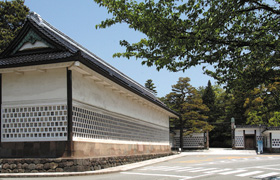Introduction: Location and Natural Geography of Kanazawa
For a World Heritage !
The Appeal of the Castle Town of Kanazawa
The city of Kanazawa is located in the centre of Ishikawa Prefecture, almost in the middle of the Japan Sea coast. Sited on the Kanazawa Plain and the surrounding hills created by the rivers that flow down from the Hakusan range, it is a medium-sized city of about 467km2 and 460,000 people. The central part of Kanazawa, some 7km2 in area, is centred on the tip of the Kodatsuno ridge, where the Kanazawa Castle site and Kenrokuen Garden are. Here, some four centuries ago, the Maedas, the rulers of this region, created their castle town and the urban structure of the modern city.
The Maedas, who were daimyo (feudal lords), chose the site of Kanazawa to be the centre of their domain administration due to the existence of the Buddhist Pure Land Sect temple, known as Kanazawa Hall, that stood here, and the large number of shopkeepers and artisans that had gathered here. In other words, the site of Kanazawa was chosen as it was religiously and economically important, and also, in terms of maritime transport, easy to build a population base. Thus it was here that an extremely carefully planned city was created, which now forms the central historical district of the modern city of Kanazawa.
The centre of the castle town of Kanazawa is comprised of the three hills of Utatsuyama, the Kodatsuno ridge, and the Teramachi ridge, and the stepped terraces formed by the two rivers, the Sai and the Asano, that flow between them. The castle, gardens, samurai districts, commoner districts, temples, as well as the roads and waterways were planned and laid out using this complex topography to best advantage. This shape is typical of Japanese castle towns, and is a classic of castle town design.

